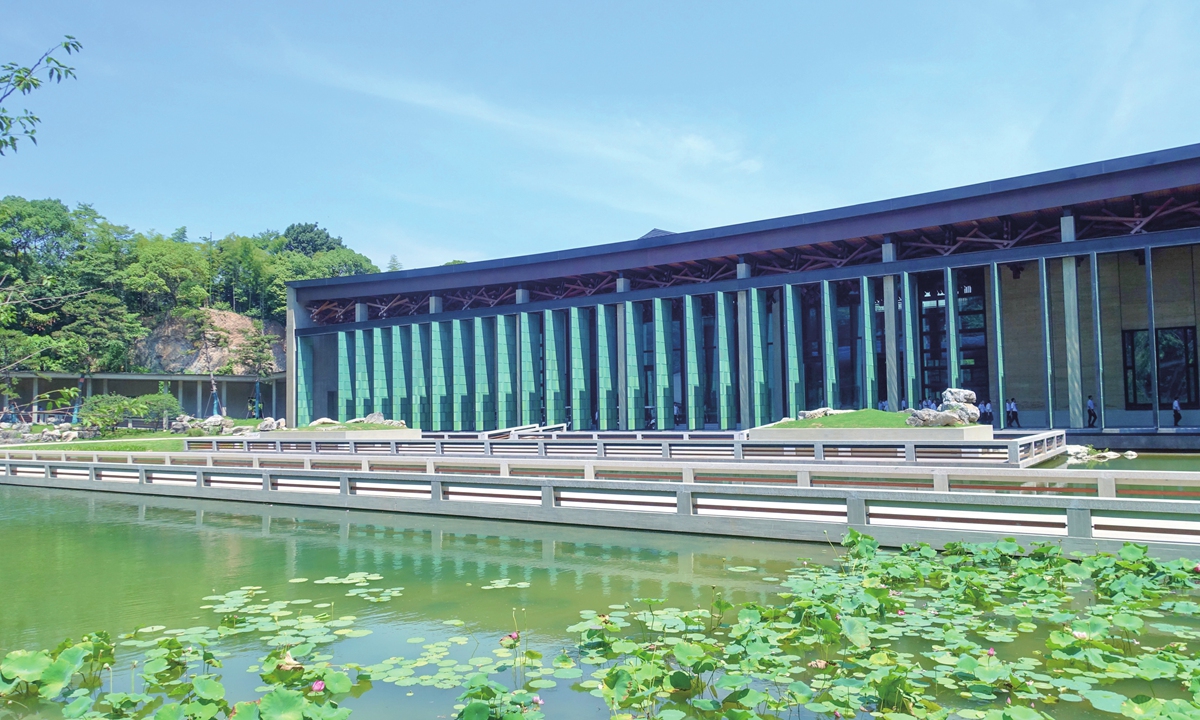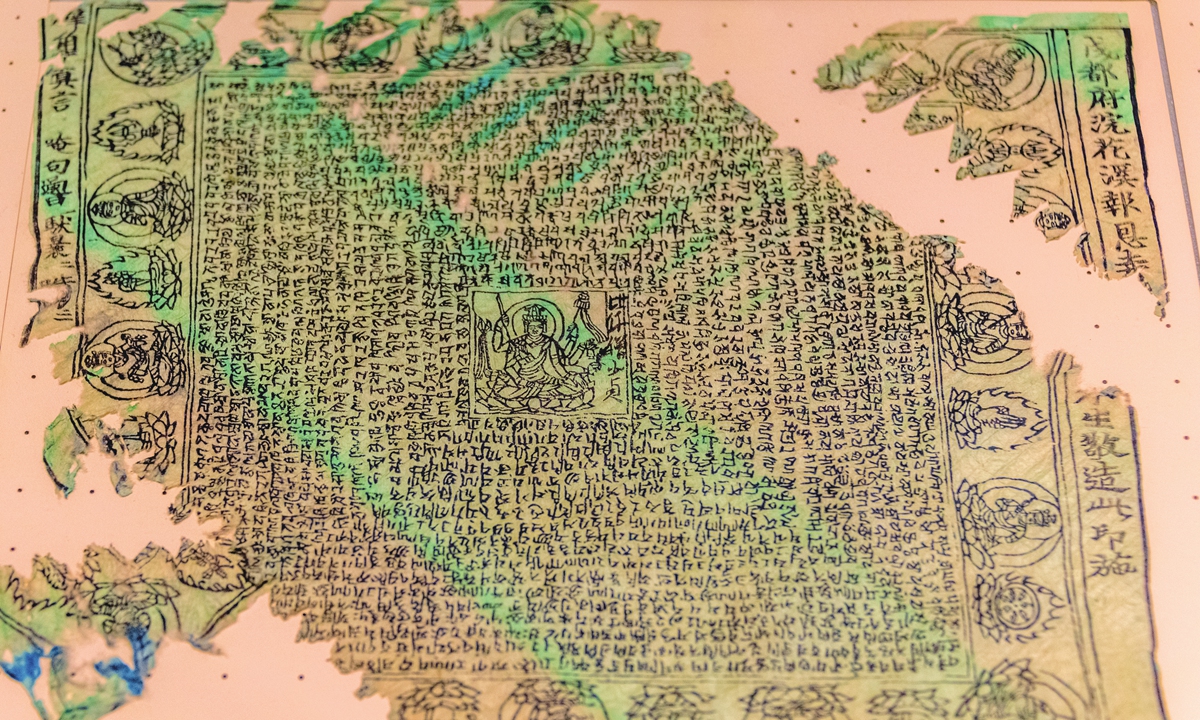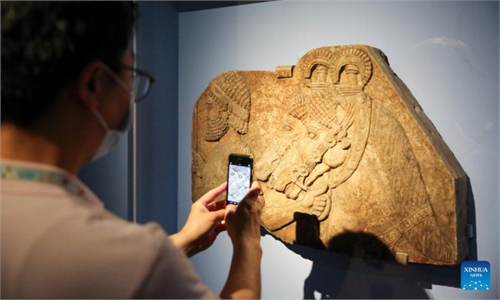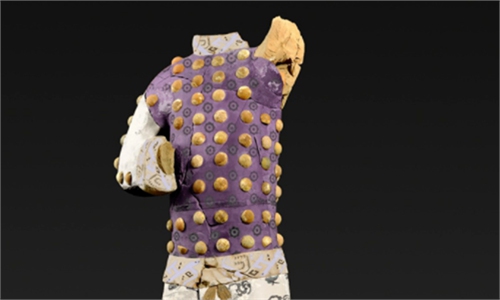ARTS / BOOKS
China builds national archives to preserve and pass on civilization
Seed bank for culture
The China National Archives of Publications and Culture, consisting of headquarters in Beijing and branches in three major Chinese cities, was inaugurated on Saturday. After a three-year construction, the institution aims to act as a "seed bank" for Chinese culture by playing a significant role in the preservation of ancient texts and modern publications in China.

The institute's three branches are in Hangzhou, East China's Zhejiang Province, Xi'an in Northwest China's Shaanxi Province and Guangzhou in South China's Guangdong Province.
With the goal of improving the inheritance of Chinese civilization, the central government started construction of the buildings in 2021.
Integrating exhibition halls, libraries, archives, museums and other functions, the archives collect physical embodiments of China's "publication cultural heritage" such as ancient books, opera masks and stamps that document Chinese civilizations.
The establishment of the institute is one of the major cultural projects supported by the central government in China's 14th Five-Year Plan (2021-25).
Zhang Yiwu, a professor at Peking University, told the Global Times on Sunday that the project will have a major impact on the inheritance of Chinese culture and the preservation of the vast quantity of Chinese texts created since writing began in China.

Bases for culture
Wu Xiaotian, leader of the planning and implementation group for the institute's headquarters, explained that the central location in Beijing will take the lead in coordinating national publication resource planning, while the three branches will gather and cover publication resources for different regions on the local level.
Unlike the main Beijing headquarters that stores some of China's most central cultural legacies, the Xi'an branch focuses in particular on China's Northwest culture, known for the cosmopolitan Tang Dynasty (618-907), while the Guangzhou branch zeros in on China's Lingnan culture, which encompasses iconic heritages such as Cantonese Opera.
Situated close to the south of the Qinling Mountains, the Xi'an branch is home to an estimated 2.09 million copies of historical texts and 160 terabytes of digital resources.
The national-level project is not only focusing on preservation, but education as well. For instance, the Xi'an branch is currently holding two exhibitions of 2,343 texts so visitors can learn more about Silk Road civilizations.
"Though these archives are defined as 'databases' for China's cultural genes, interactive events serve the goals of public education and passing on culture. Therefore, I predict this project will have a range of diverse activities in the future that will make it even more influential," Sun Shuyi, a historian and museum expert, told the Global Times.
All three branches have multiple sections that serve as not only exhibition halls, but also libraries and archives. For instance, the Guangzhou branch covers an area of 246,900 square meters and its Wenqin Pavilion can store about 2.65 million texts. Many of the rare publications in the archives were donated by private collectors.
For example, 782 volumes of precious ancient books were donated by collector/businessmen Jin Liang to the Hangzhou branch in 2021.
As a densely populated and industrialized area since ancient times, Hangzhou also assumes the responsibility of preserving Jiangnan culture, which encompasses the eastern part of China.
The Hangzhou branch will be also responsible for academic communication between the various branches and other types of institutions in China and around the world.
The branch is situated near the Archaeological Ruins of Liangzhu, once home to an early regional state that had already begun cultivating rice more than 5,000 years ago.
"The venues are positioned to inherit traditional Chinese culture, which is why we chose the location near Liangzhu, an area where China's 5,000-year-old civilization started," well-known architect Wang Shu, who also designed and built the complex, told local media.
To date, the Hangzhou complex, made up of 13 units, has received a total of 1 million important texts such as The Communist Manifesto in various languages donated by local bureaus and offices and private collectors.
"Before the project, we understood the huge significance of the program and the responsibility we were bearing. This is an ancient book archive in the modern era and is an institution for inheriting Chinese history and culture," added Wang.
Increased influence
According to Wu, besides preserving and passing on culture, the archives will also strengthen Chinese people's cultural confidence, present a strong cultural image and promote dialogues among the world's civilizations.
Zhang, the professor, added that with the institute, more attention is sure to be paid to Chinese texts, while research into these important works of culture will have a base camp.
A 28-year-old publisher surnamed Wei told the Global Times that the establishment of the archives shows the central government's concern of ancient texts and modern publications and that she is glad to see that these exquisite cultural products will be preserved for future generations.

The Hangzhou branch of the China National Archives of Publications and Culture Photo: IC
The institute's three branches are in Hangzhou, East China's Zhejiang Province, Xi'an in Northwest China's Shaanxi Province and Guangzhou in South China's Guangdong Province.
With the goal of improving the inheritance of Chinese civilization, the central government started construction of the buildings in 2021.
Integrating exhibition halls, libraries, archives, museums and other functions, the archives collect physical embodiments of China's "publication cultural heritage" such as ancient books, opera masks and stamps that document Chinese civilizations.
The establishment of the institute is one of the major cultural projects supported by the central government in China's 14th Five-Year Plan (2021-25).
Zhang Yiwu, a professor at Peking University, told the Global Times on Sunday that the project will have a major impact on the inheritance of Chinese culture and the preservation of the vast quantity of Chinese texts created since writing began in China.

A wood block print of Usnisa Vijaya Dharani Sutra dating to the Tang Dynasty (618-907) Photo: VCG
Bases for culture
Wu Xiaotian, leader of the planning and implementation group for the institute's headquarters, explained that the central location in Beijing will take the lead in coordinating national publication resource planning, while the three branches will gather and cover publication resources for different regions on the local level.
Unlike the main Beijing headquarters that stores some of China's most central cultural legacies, the Xi'an branch focuses in particular on China's Northwest culture, known for the cosmopolitan Tang Dynasty (618-907), while the Guangzhou branch zeros in on China's Lingnan culture, which encompasses iconic heritages such as Cantonese Opera.
Situated close to the south of the Qinling Mountains, the Xi'an branch is home to an estimated 2.09 million copies of historical texts and 160 terabytes of digital resources.
The national-level project is not only focusing on preservation, but education as well. For instance, the Xi'an branch is currently holding two exhibitions of 2,343 texts so visitors can learn more about Silk Road civilizations.
"Though these archives are defined as 'databases' for China's cultural genes, interactive events serve the goals of public education and passing on culture. Therefore, I predict this project will have a range of diverse activities in the future that will make it even more influential," Sun Shuyi, a historian and museum expert, told the Global Times.
All three branches have multiple sections that serve as not only exhibition halls, but also libraries and archives. For instance, the Guangzhou branch covers an area of 246,900 square meters and its Wenqin Pavilion can store about 2.65 million texts. Many of the rare publications in the archives were donated by private collectors.
For example, 782 volumes of precious ancient books were donated by collector/businessmen Jin Liang to the Hangzhou branch in 2021.
As a densely populated and industrialized area since ancient times, Hangzhou also assumes the responsibility of preserving Jiangnan culture, which encompasses the eastern part of China.
The Hangzhou branch will be also responsible for academic communication between the various branches and other types of institutions in China and around the world.
The branch is situated near the Archaeological Ruins of Liangzhu, once home to an early regional state that had already begun cultivating rice more than 5,000 years ago.
"The venues are positioned to inherit traditional Chinese culture, which is why we chose the location near Liangzhu, an area where China's 5,000-year-old civilization started," well-known architect Wang Shu, who also designed and built the complex, told local media.
To date, the Hangzhou complex, made up of 13 units, has received a total of 1 million important texts such as The Communist Manifesto in various languages donated by local bureaus and offices and private collectors.
"Before the project, we understood the huge significance of the program and the responsibility we were bearing. This is an ancient book archive in the modern era and is an institution for inheriting Chinese history and culture," added Wang.
Increased influence
According to Wu, besides preserving and passing on culture, the archives will also strengthen Chinese people's cultural confidence, present a strong cultural image and promote dialogues among the world's civilizations.
Zhang, the professor, added that with the institute, more attention is sure to be paid to Chinese texts, while research into these important works of culture will have a base camp.
A 28-year-old publisher surnamed Wei told the Global Times that the establishment of the archives shows the central government's concern of ancient texts and modern publications and that she is glad to see that these exquisite cultural products will be preserved for future generations.


